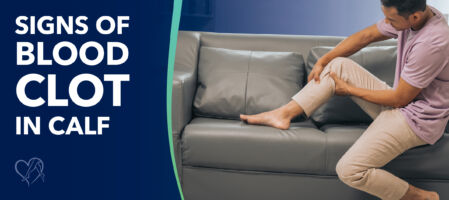
A blood clot can form anywhere in the body, but according to News in Health, it typically develops in the lower leg or the thigh. A blood clot that forms in a vein deep inside the body as opposed to a superficial vein close to the surface of the skin is called deep vein thrombosis (DVT). This condition has many symptoms, several of which are consistent with other venous disorders, such as pain, swelling, and redness.
If you’re suffering from any signs that may indicate higher clotting risks, the board-certified physicians at Center for Vein Restoration (CVR) are here to provide the clarity and support you need. We help individuals concerned about blood clots navigate their treatment options and manage their care and recovery.

Of course, the first step is understanding the potential signs of a major clot, particularly in the legs. DVTs in the calf, for example, also called calf vein thrombosis or isolated distal DVTs, comprise up to 50 percent of all lower-limb DVTs. According to the National Library of Medicine, this classifies them as a frequent medical condition. Keep reading as we discuss what causes blood to clot, particularly in the calf, and several signs of a distal DVT.
Knowing how a healthy blood clot forms helps provide insight into why distal DVTs are such a common form of lower-limb DVTs. Clotting is the body’s natural defense mechanism from bleeding. A healthy clot forms to prevent damaged blood vessels from losing too much blood and encourage healing instead.
However, a DVT is often accompanied by symptoms such as:
According to Penn Medicine, blood clot symptoms vary depending on where they’re located. Clots in the arms and legs are most often accompanied by swelling — potentially sudden — as well as tenderness and a possible warm feeling.
If you experience any of these symptoms, it’s important to contact your doctor immediately. A DVT could lead to or coincide with a pulmonary embolism, which occurs when the clot breaks off and travels to a vessel in the lung — a potentially fatal condition.
Meanwhile, some DVTs are much more subtle. According to the Cleveland Clinic, up to 30 percent of people with a DVT don’t have symptoms, and they don’t know it exists until it turns into a serious pulmonary embolism. The bottom line? Even acute symptoms should be explored to rule out a DVT.
Are you wondering why your blood clot formed in the calf? There are several causes of below-knee DVTs, each involving the way the blood slows down and stops flowing normally:
While DVTs in the lower legs are relatively common, blood clots in the calf are problematic and can have worsened side effects. For example, while we’ve discussed that swelling is a common sign of blood clots, an isolated distal DVT often has more severe swelling than a typical clot.
Similarly, isolated distal DVTs can easily travel to other areas of the body based on where they form. When the clot forms along the veins of the calf, it has the chance to enter the vessels of the thigh, where it can break off and travel to the lungs.
While anyone can develop a DVT, certain people are more prone than others based on a series of risk factors, including:
Certain conditions and illnesses, such as sickle cell disease, spinal cord injuries, COVID-19, cancer, and heart failure, can impact the risk of developing DVT as well, according to Harvard Health.
How can you manage your symptoms after developing a blood clot in the calf? While returning to your usual fitness routine may not be realistic at first, it’s important to take small measures to improve your activity level and boost your overall circulation.
If your legs feel swollen, try lying in bed and keeping them elevated between five and six inches to decrease the effect of gravity.
Boosting circulation means adding more movement to your day. Stand up and walk around for a few minutes each waking hour, particularly if you’re on a long flight or road trip.
Be sure you’re getting enough fluids throughout the day. This helps improve circulation, especially during travel times.
Purchasing a pair of knee-high medical-grade compression stockings can help boost blood flow while drastically reducing swelling and pain. Ask your board-certified CVR physician if you’d like help measuring for a perfect fit, and re-measure and replace them every three to six months to make sure that fit is still just right.
Swelling, pain, tenderness, skin discoloration…are you experiencing any of these signs that may indicate a blood clot in the calf? If so, it’s important to contact a doctor — don’t wait!
Center for Vein Restoration (CVR) provides a comprehensive DVT rule-out service for those who suspect they may have a DVT. This all-in-one solution includes a scan, anticoagulation treatment, education, and necessary follow-up. For immediate assistance, call our DVT hotline at 877-SCAN-DVT (877-722-6388).
In addition to our DVT rule-out services, CVR also provides a wide range of treatment options for spider veins, varicose veins, and other signs of chronic venous insufficiency.
Curious to learn more? Take your venous health into your own hands and get the relief you’ve been waiting for. Call 240-965-3915 or click here to book your consultation immediately with a board-certified CVR vein expert.
